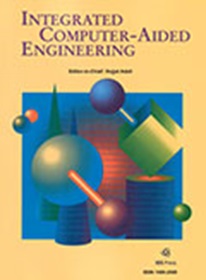A fitting algorithm based on multi-touch gesture for rapid generation of railway line
IF 5.8
2区 计算机科学
Q1 COMPUTER SCIENCE, ARTIFICIAL INTELLIGENCE
引用次数: 0
Abstract
Human-computer interaction (HCI) technology plays a critically essential role in the computer-aided design of railway line locations. However, the traditional interactive design with a mouse+keyboard cannot well meet the rapid generation requirements of the railway line during scheme discussion. This research presents a fitting algorithm for the rapid generation of railway lines by using a multi-touch gesture algorithm. The fitting method from free hand-drawing lines to satisfied railway lines is proposed. Then the interactive operation hand gestures are defined and implemented into the railway line location design. The hand-drawing lines generated by defined gestures are automatically fitted with the target horizontal line by using the inflection detection algorithm based on Euclidean Distance (ED). Meanwhile, the vertical line can be fitted by a similar algorithm with an extreme point-to-point (EPP) and chord-to-point distance accumulation (CPDA). Moreover, a real-world example verification is carried out. The multi-touch gesture algorithm is applied for the automatic fitting of the railway line. Compared with the traditional interactive methods, the consumption time of railway line generation by using the multi-touch interactive mode is decreased by about 15%. This research provides fundamental support for rapid scheme discussion of railway line generation based on natural HCI, which is well-matched with modern handheld devices, and the requirements of rapid selection as well as the quick comparison of railway line schemes in the early stage of design.基于多点触控手势的铁路线路快速生成拟合算法
人机交互技术在铁路线路位置计算机辅助设计中起着至关重要的作用。然而,在方案讨论中,传统的鼠标+键盘交互设计不能很好地满足铁路线路快速生成的要求。本文提出了一种基于多点触控手势的快速生成铁路线的拟合算法。提出了从自由手绘线到满足的铁路线的拟合方法。然后定义了交互式操作手势,并将其应用到铁路线路定位设计中。通过基于欧几里得距离(ED)的拐点检测算法,将手势生成的手绘线与目标水平线自动拟合。同时,利用极值点对点(EPP)和弦对点距离累积(CPDA)的类似算法拟合垂直线。并进行了实例验证。将多点触控手势算法应用于铁路线路的自动配线。与传统的交互方式相比,采用多点触控交互方式生成铁路线的消耗时间减少了约15%。本研究为与现代手持设备相匹配的基于自然人机交互的铁路线生成快速方案讨论,以及在设计初期快速选择和快速比较铁路线方案的需求提供了基础支持。
本文章由计算机程序翻译,如有差异,请以英文原文为准。
求助全文
约1分钟内获得全文
求助全文
来源期刊

Integrated Computer-Aided Engineering
工程技术-工程:综合
CiteScore
9.90
自引率
21.50%
发文量
21
审稿时长
>12 weeks
期刊介绍:
Integrated Computer-Aided Engineering (ICAE) was founded in 1993. "Based on the premise that interdisciplinary thinking and synergistic collaboration of disciplines can solve complex problems, open new frontiers, and lead to true innovations and breakthroughs, the cornerstone of industrial competitiveness and advancement of the society" as noted in the inaugural issue of the journal.
The focus of ICAE is the integration of leading edge and emerging computer and information technologies for innovative solution of engineering problems. The journal fosters interdisciplinary research and presents a unique forum for innovative computer-aided engineering. It also publishes novel industrial applications of CAE, thus helping to bring new computational paradigms from research labs and classrooms to reality. Areas covered by the journal include (but are not limited to) artificial intelligence, advanced signal processing, biologically inspired computing, cognitive modeling, concurrent engineering, database management, distributed computing, evolutionary computing, fuzzy logic, genetic algorithms, geometric modeling, intelligent and adaptive systems, internet-based technologies, knowledge discovery and engineering, machine learning, mechatronics, mobile computing, multimedia technologies, networking, neural network computing, object-oriented systems, optimization and search, parallel processing, robotics virtual reality, and visualization techniques.
 求助内容:
求助内容: 应助结果提醒方式:
应助结果提醒方式:


